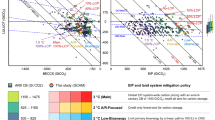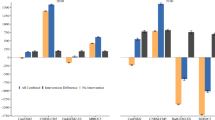Abstract
A methodology is presented to construct supply curves and cost–supply curves for carbon plantations based on land-use scenarios from the Integrated Model to Assess the Global Environment (IMAGE 2). A sensitivity analysis for assessing which factors are most important in shaping these curves is also presented. In the IPCC SRES B2 Scenario, the carbon sequestration potential on abandoned agricultural land increases from 60 MtC/year in 2010 to 2,700 MtC/year in 2100 for prices up to 1,000 $/tC, assuming harvest when the mean annual increment decreases and assuming no environmental, economical or political barriers in the implementation-phase. Taking these barriers into consideration would reduce the potential by at least 60%. On the other hand, the potential will increase 55 to 75% if plantations on harvested timberland are considered. Taking into account land and establishment costs, the largest part of the potential up to 2025 can be supplied below 100 $/tC (In this article all dollar values are in US dollars of 1995, unless indicated otherwise.). Beyond 2050, more than 50% of the costs come to over 200 $/tC. Compared to other mitigation options, this is relative cheap. So a large part of the potential will likely be used in an overall mitigation strategy. However, since huge emission reductions are probably needed, the relative contribution of plantations will be low (around 3%). The largest source of uncertainty with respect to both potentials and costs is the growth rate of plantations compared to the natural vegetation.








Similar content being viewed by others
Notes
In the Agricultural Economy Model (AEM), food products are associated with so-called ‘intensities,’ which indicate the amount of land needed to supply 1 Kcal per day of the product considered, taking into account the conversion from feed to meat. Because prices do not exist in the AEM, intensities are considered to be a proxy for prices. More details can be found in Strengers (2001).
The Net Primary Productivity of an ecosystem is the rate at which it accumulates energy or biomass, excluding the energy it uses for the process of respiration. This typically corresponds to the rate of photosynthesis, minus respiration.
The demand for wood products is based on a statistical relationship between wood production, population growth, industrial value added and the availability of forests (see Alcamo et al. 1998). The demand for fuel wood and charcoal is assumed to be a fixed fraction of the demand for traditional biofuels, as computed by the energy model TIMER (De Vries 2001).
Benítez et al. assess that risks associated with political, economic, and financial circumstances reduces the global carbon sequestration potential by approximately 60%.
References
Alcamo J, Kreileman E, Krol M, Leemans R, Bollen J, Van Minnen J, Schaeffer M, Toet S, De Vries B (1998) Global modelling of environmental change: on overview of IMAGE 2.1. In: Alcamo J, Leemans R, Kreileman E (eds) Global change scenarios of the 21st century. Results from the IMAGE 2.1 model. Elsevier Science, London, pp 3–94
Benítez-Ponce PC (2005) Essays on the economics of forestry-based carbon mitigation, PhD Thesis, Wageningen University, pp 77–78
Benítez-Ponce PC, Obersteiner M (2006) Site identification for carbon sequestration in Latin-America: a grid-based economic approach. Forest Policy and Economics 8(6):636–651
Bouwman AF, Kram T, Klein Goldewijk K (eds) (2006) Integrated modelling of global environmental change. An overview of IMAGE 2.4. Netherlands Environmental Assessment Agency (MNP), Bilthoven. MNP publication number 500110002/2006
Bruinsma JE (2003) World agriculture: towards 2015/2030. An FAO Perspective. Earthscan, London, 432 pp
Carpenter S, Pingali P (2005) Millenium ecosystem assessment—scenarios assessment. Island, Washington, DC
Criqui P, Russ P, Deybe D (2006) Impacts of multi-gas strategies for greenhouse gas emission abatement: Insights from a partial equilibrium model. Energy Journal, Special Issue no. 3
de Vries B (2001) The Targets IMage Energy Regional (TIMER) model. Technical Documentation, RIVM report no. 461502024. See also http://www.mnp.nl/image/model_details/energy_demand_supply/
Den Elzen MGJ, Lucas P (2003) FAIR 2.0—De decision-support tool to assess the environmental and economic consequences of future climate regimes. Report 550015001/2003, RIVM/MNP, Bilthoven
Graveland C, Bouwman AF, de Vries HJM, Eickhout B, Strengers BJ (2002) Projections of multi-gas emissions and carbon sinks, and marginal abatement cost functions modeling for land-use related sources. Report 461502026, National Institute of Public Health and the Environment (RIVM), Bilthoven
GTAP (2004) The GTAP 6 Data package. Purdue University, USA
Heath J, Ayres E, Possell M, Bardgett RD, Black HIJ, Grant H, Ineson P, Kerstiens G (2005) Rising atmospheric CO2 reduces sequestration of root-derived soil carbon. Science 309:1711–1713
Hoogwijk M (2004) On the global and regional potential of renewable energy sources. PhD-thesis. Science, Technology and Society. Utrecht University
Hoogwijk M, Faaij A, Eickhout B, de Vries B, Turkenburg W (2005) Potential of biomass energy out to 2100, for four IPCC SRES land-use scenarios. Biomass Bioenergy 29:225–257
IMAGE team (2001) The IMAGE 2.2 implementation of the SRES scenarios: A comprehensive analysis of emissions, climate change and impacts in the 21st century. RIVM CD-ROM Publication 481508018, National Institute of Public Health and the Environment, Bilthoven
IPCC (1996) Climate change 1995. Economic and social dimensions of climate change. Intergovernmental Panel on Climate Change (IPCC). Cambridge, p 248, p 349
Jakeman G, Fisher BS (2006) Benefits of multi-gas mitigation: An application of the Global Trade and Environment Model (GTEM). Energy Journal, Special Issue no. 3
Körner Ch, Asshoff R, Bignucolo O, Hattenschwiler S, Keel SG, Pelaez-Riedl S, Pepin S, Siegwolf RTW, Zotz G (2005) Carbon flux and growth in mature deciduous forest trees exposed to elevated CO2. Science 309:1360–1362
Kunte A, Hamilton K, Dixon J, Clemens M (1998) Estimating national wealth: methodology and results. Indicators and environmental valuation. World Bank, Washington, DC
Leemans R, Eickhout BJ, Strengers B, Bouwman AF, Schaeffer M (2003) The consequences for the terrestrial carbon cycle of uncertainties in land use, climate and vegetation responses in the IPCC SRES scenarios. Science in China 43:1–15
McCarl BA, Schneider UA (2001). The cost of GHG mitigation in U.S. Agriculture and Forestry. Science 294:2481–2482
Metz B, Berk M, Kok M, Van Minnen JG, De Moor A, Faber A (2001) How can the European Union contribute to a CoP-6 agreement? An overview for policy makers. International Environmental Agreement: Politics, Law and Economics 1:167–185
Mitchell JFB, Karoly DJ, Hegerl G, Zwiers FW, Marengo J (2001) Detection of climate change and attribution of causes. Chapter 12 WGI, IPCC Third Assessment Report on Climate Change, Cambridge University Press
Morita T, Robinson J, Adegbulugbe A, Alcamo J, Herbert D, Lebre la Rovere E, Nakicenivic N, Pitcher H, Raskin P, Riahi K, Sankovski A, Solkolov V, de Vries B, Zhou D (2001) Greenhouse gas emission mitigation scenarios and implications. In: Metz B, Davidson O, Swart R, Pan J (eds) Climate change 2001: mitigation; contribution of working group III to the third assessment report of the IPCC. Cambridge University Press, Cambridge, Chapter 2, pp 115–166
Nabuurs GJ, Schelhaas MJ, Mohren GMJ, Field CB (2003) Temporal evolution of the European forest sector carbon sink from 1950–1999. Glob Chang Biol 9:152–160
Nakicenovic N, Alcamo J, Davis G, de Vries B, Fenhann J, Gaffin S, Gregory K, Grübler A, Jung TY, Kram T, Emilio la Rovere E, Michaelis L, Mori S, Morita T, Pepper W, Pitcher H, Price L, Riahi K, Roehrl A, Rogner H-H, Sankovski A, Schlesinger ME, Shukla PR, Smith S, Swart RJ, van Rooyen S, Victor N, Dadi Z (eds) (2000) IPCC Special Report on Emissions Scenarios. Cambridge University Press
Nilsson S, Schopfhauser W (1995) The carbon-sequestration potential of a global afforestation program. Clim Change 30:267–293
Ravindranath N, Somashekhar B (1995) Potential and economics of forestry options for carbon sequestration in India. Biomass Bioenergy 8:323–336
Richards KR, Stokes C (2004) A review of forest carbon sequestration cost studies: a dozen years of research. Clim Change 63:1–48
Sathaye J, Makundi W, Dale L, Chan P, Andrasko K (2006) GHG mitigation potential, costs and benefits in global forests: a dynamic partial equilibrium approach. Energy J (The multi-greenhouse gas mitigation and climate policy special)
Sathaye JA, Markundi W, Andrasko K, Boer R, Ravindranath NH, Sudha P, Rao S, Lasco R, Pulhin F, Masera O, Ceron A, Ordonez J, Deying X, Zhang X, Zuomin S (2001) Carbon mitigation potential and costs of forestry options in Brazil, China, India, Indonesia, Mexico, the Philippines and Tanzania. Mitig Adapt Strategies Glob Chang 6:185–211
Schlamadinger B, Marland G (1997) The role of forest and bioenergy strategies in the global carbon cycle. Fuel Energy Abstr 38:116–120
Sohngen B, Mendelsohn R (2003) An optimal control model of forest carbon sequestration. Am J Agric Econ 85(2):448–457
Sohngen B, Sedjo R (2006) Carbon sequestration costs in global forests. Energy Journal, Volume: Multi-Greenhouse Gas Mitigation and Climate Policy, Special Issue #3
Strengers B (2001) The agricultural economy model in IMAGE 2.2, RIVM report 481508015. See also http://www.mnp.nl/image/model_details/agricultural_economy/
Strengers B, Leemans R, Eickhout B, De Vries B, Bouwmann L (2004) The land-use projections and resulting emissions in the IPCC SRES scenarios as simulated by the IMAGE 2.2. model. GeoJournal 61:381–393
Trines E (2003) Abatement and independent verification costs of sinks CDM projects: an inventory of experience. Treeness Consultant
UN (2004) World population to 2300. United Nations, New York
Van Minnen JG, Klein Goldewijk K, Leemans R, Kreileman GJJ (1996) Documentation of a geographically explicit dynamic carbon cycle model. RIVM report nr 481507007. See also http://www.mnp.nl/image/model_details/terrestrial_carbon/
Van Minnen JG, Strengers B, Eickhout B, Leemans R, Swart R (2007) Evaluating the role of carbon plantations in climate change mitigation including land-use requirements. Carbon Balance and Management (in press)
Van Vuuren DP, O’Neill BC (2006) The consistency of IPCC’s SRES scenarios to 1990–2000 trends and recent projections. Clim Change 75:9–46
Van Vuuren D, den Elzen M, Lucas P, Eickhout B, Strengers B, van Ruijven B, Wonink S, van den Houdt R (2007) Stabilising greenhouse gas concentrations at low levels. An assessment of reduction strategies and costs. Clim Change 81:119–159
Waterloo MJ, Spiertz PH, Diemont H, Emmer I, Aalders E, Wichink-Kruit R, Kabat P (2001) Criteria potentials and costs of forestry activities to sequester carbon within the framework of the clean development meachanism. Alterra Green world Research, Wageningen, The Netherlands
Watson RT, Noble IR, Bolin B, Ravindranth NH, Verado D, Dokken DJ (eds) (2000) IPCC Special report on Land Use, Land-use Change, and Forestry. Cambridge University Press, p 377
Xu D (1995) The potential for reducing atmospheric carbon by large-scale afforestation in China and related cost/benefit analysis. Biomass Bioenergy 8(5):337–344
Xu D, Zhang X, Shi Z (2001) Mitigation potential for carbon sequestration through forestry activities in Southern and Eastern China. Mitig Adapt Strategies Glob Chang 6:213–232
Author information
Authors and Affiliations
Corresponding author
Rights and permissions
About this article
Cite this article
Strengers, B.J., Van Minnen, J.G. & Eickhout, B. The role of carbon plantations in mitigating climate change: potentials and costs. Climatic Change 88, 343–366 (2008). https://doi.org/10.1007/s10584-007-9334-4
Received:
Accepted:
Published:
Issue Date:
DOI: https://doi.org/10.1007/s10584-007-9334-4




